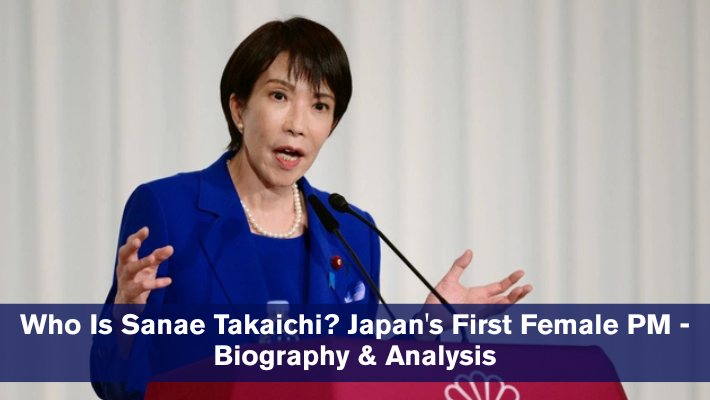Sanae Takaichi: From Kobe University to LDP Presidency
Sanae Takaichi (born 1961) is a prominent Japanese politician and the first woman to lead the Liberal Democratic Party (LDP). From her early days in Nara and Kobe University to multiple ministerial roles under Shinzo Abe, she has championed economic security, constitutional revision, and conservative social policies. This full biography examines her rise, ideology, and the challenges she faces in vying to become Japan’s first female prime minister.
Sanae Takaichi: Biography & Political Journey
Early Life and Education
Sanae Takaichi (高市 早苗, Takaichi Sanae) was born on March 7, 1961, in Yamatokōriyama, Nara Prefecture, Japan. Her father was employed in an automobile company affiliated with Toyota, and her mother worked in the Nara Prefectural Police. She attended Nara Prefectural Unebi High School.
Though she qualified for Tokyo universities such as Keio and Waseda, her parents declined to fund her relocation or attendance at private institutions, so she remained nearer home.
In March 1984, Takaichi graduated from the Faculty of Business Administration at Kobe University.After that, she worked in various roles: as a broadcaster, legislative aide, and author, before fully stepping into politics.
She also studied at (or was affiliated with) the Matsushita Institute of Government and Management.
Entry into Politics and Early Career
Takaichi first entered the political arena when she was elected to the House of Representatives in the general election of July 1993 as an independent. She changed party affiliations in the mid-1990s: joining the Liberals, then the New Frontier Party, and finally the Liberal Democratic Party (LDP) in 1996.
In the 2000 general election, she secured a high place on the LDP’s proportional representation list and won her third term.
Under Prime Minister Junichiro Koizumi, she served as Senior Vice Minister of the Ministry of Economy, Trade and Industry.
Ministerial Posts and Political Rise
Takaichi’s ministerial experience is broad, spanning multiple portfolios and administrations, especially under Shinzo Abe.
Notable ministerial roles include:
- Minister of State for Okinawa and Northern Territories Affairs
- Minister of State for Science and Technology Policy
- Minister of State for Innovation
- Minister of State for Youth Affairs & Gender Equality
- Minister of State for Food Safety
(All of these held during the First Abe Cabinet period, 2006–2007) - Minister for Internal Affairs and Communications (first from September 2014 to August 2017, then again from September 2019 to September 2020)
- Minister of State for Economic Security (under Fumio Kishida) from August 2022 to October 2024
Takaichi was also the Chairperson of the LDP’s Policy Research Council.
In mid-2024, she ran for LDP leadership and came first in the initial round, but lost narrowly in the runoff to Shigeru Ishiba.
In 2025, she again contested and this time won the leadership of the LDP, defeating Shinjirō Koizumi in the second round, thereby becoming party president on October 4, 2025.
Political Positions & Ideology
Takaichi is known as a staunch conservative or “ultraconservative.”
Domestic / Social Issues
- She supports continuation of “Abenomics” (the economic policies advanced under Abe)
- She has expressed opposition to same-sex marriage and to legislation allowing married women to retain their maiden names.
- She has opposed the idea of an empress regnant (female emperor) and tends to lean toward traditional gender roles in some respects.
Constitutional & Security Views
- She favors revising Article 9 of Japan’s Constitution (which renounces war), to allow Japan more flexibility in defense and military posture.
- She supports strengthening the US–Japan alliance, taking a tougher stance on China, and advocating for national security, cyber, and space defense strategies.
- She is affiliated with Nippon Kaigi, a conservative nationalist organization, and has at times taken positions minimizing or challenging certain aspects of Japan’s wartime history.
- She supports visits to Yasukuni Shrine (a controversial site commemorating Japan’s war dead, including convicted wartime leaders).
Personal Life
Takaichi married Taku Yamamoto (also a politician) in 2004. They have no biological children, but she has adopted her husband’s three children and is a grandmother.
She is renowned for her disciplined lifestyle and strong emphasis on education.
Significance & Challenges
Her rise marks a major milestone: if she becomes prime minister, she would become Japan’s first female prime minister.
However, her path is not without criticism: her conservative social stances, historical views, and alignment with nationalist elements provoke both domestic and international attention and sometimes protest (especially from neighboring countries like China and South Korea).
Japan has long struggled with gender parity in politics: women occupy a relatively small percentage of parliamentary seats. Her leadership could be a symbolic shift in a male-dominated field.
Her political and policy orientations suggest that under her leadership, Japan may continue or intensify policies on defense, economic security, and possibly constitutional revision, while maintaining conservative stances on social issues.





